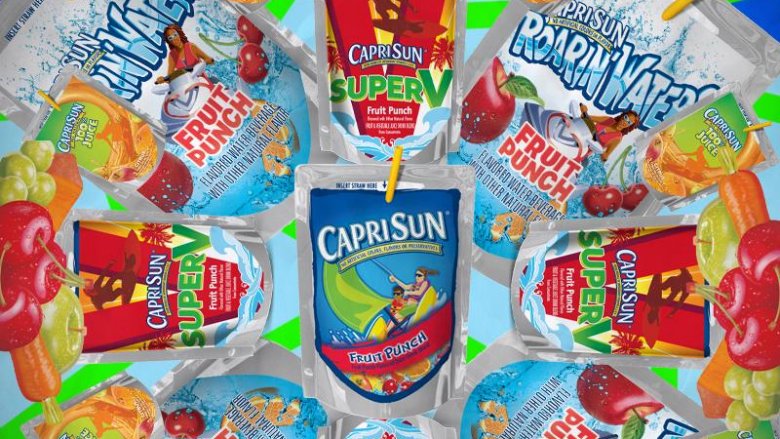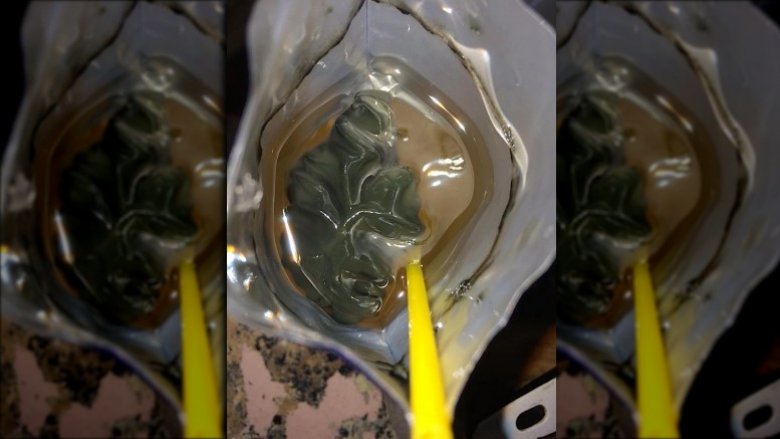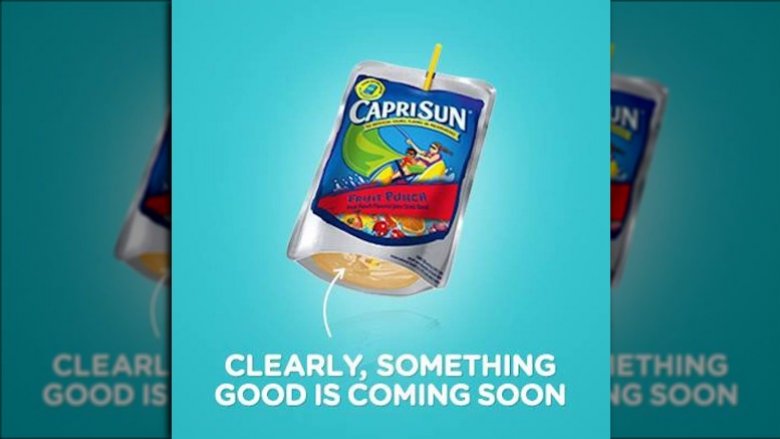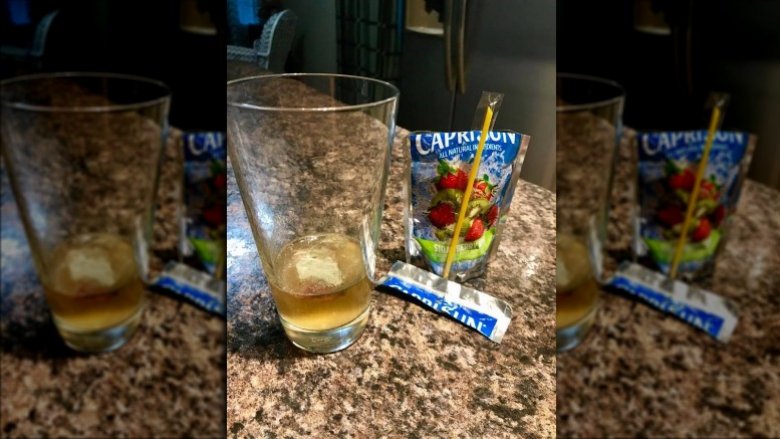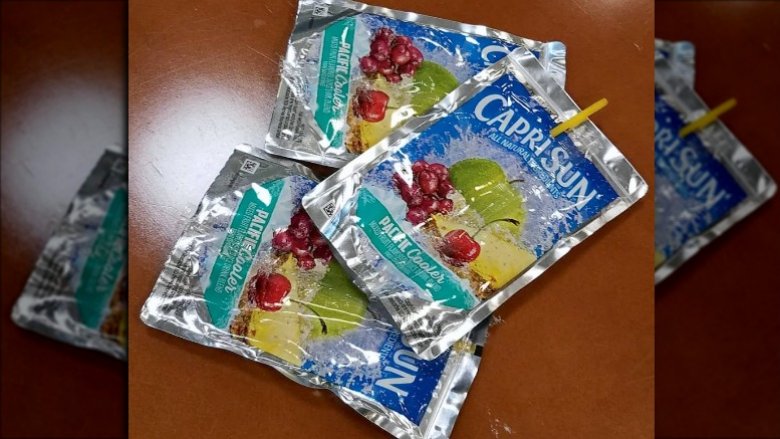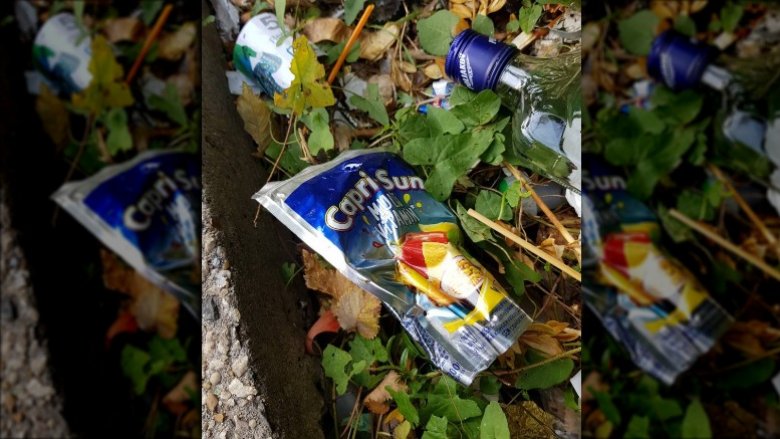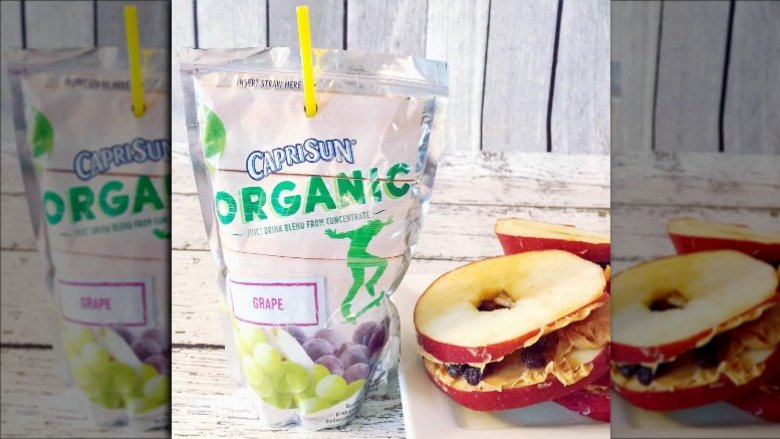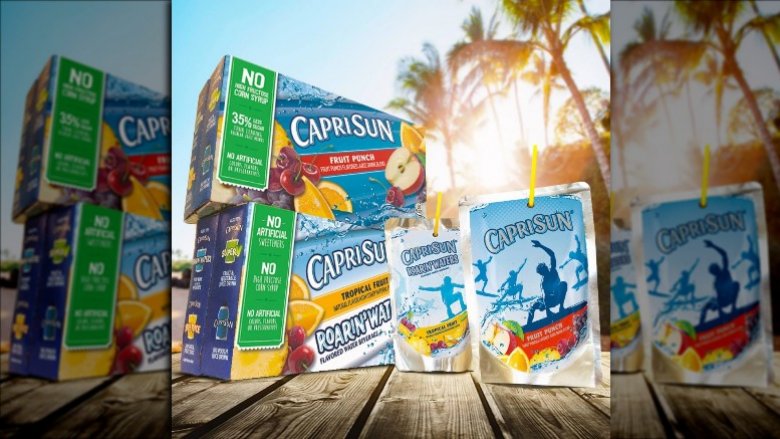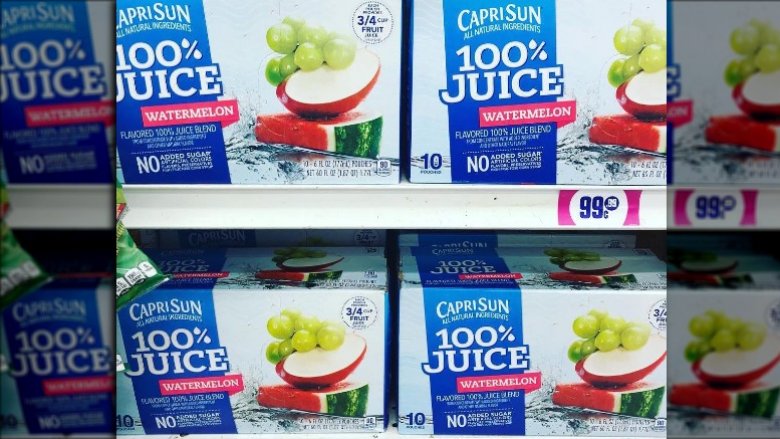The Shady Truth About Capri Sun
Capri Sun, with its iconic silver pouch, was a staple in many of our childhood lunchboxes. Most of us experienced that oh-so-embarrassing moment in the cafeteria when we poked the straw through the backside of the pouch causing half the drink to drain into our laps, and subsequently giving a roomful of elementary school kids plenty of ammunition for jokes. Aside from the potential of being named the "kid who wet their pants" thanks to a leaky Capri Sun, you probably remember the fruit juice drink being pretty awesome.
But now that you're all grown up (and thanks to social media), you may have read some of the shadier things about Capri Sun, like the cringe-worthy accounts of all the unappetizing discoveries parents have found in the pouches — things described as "slime" and "worms," just waiting to be slurped up by their kids. It turns out that these pouches, which happen to be wreaking havoc on the environment, also play host to a fungi party.
Still feeling nostalgic for the lunchbox favorite? You might not be reaching for a Capri Sun after learning these unsavory tidbits.
They have a long history of mold
Thanks to the internet, we have all kinds of horrifyingly useful information at our fingertips. Like the Capri Sun mold problem, for instance.
For at least the last 10 years, folks have been posting online about all the gross things they've found in their juice pouches. Some claim the affected drinks taste carbonated, or like alcohol, while others can't actually suck the liquid up through the straw due to an obstruction.
"It tasted as if it were carbonated. I dumped it into a glass to take a look. Just as I was afraid there seemed to be some sort of growth, almost web like only slightly darker than the color of the drink itself (light pinkish almost clear)," one concerned consumer posted to the now-defunct Yahoo Answers a decade ago.
In 2012, one mom explained the unfortunate experience her 10-year-old boy had with his Capri Sun: "He went to go take a sip of the drink and he started choking," she said. "So he pulled the worm out of his mouth and he was like, 'Oh mommy, this is nasty.'"
Another mom related a similar story about her daughter's drink in 2015, saying, "She couldn't suck up, something was blocking it. And that's when I looked in there and you could see a glob of something in there."
And there's more where that came from. Stories like these abound with a simple internet search for "Capri Sun mold."
The move to clear bottoms
So what's a company to do in the face of all these mold claims? Use it to their advantage, that's what.
In response to each instance of a consumer finding "something" in their Capri Sun, Kraft Foods routinely provided fairly blasé statements along the lines of: "Since our Capri Sun products are made without preservatives — a fact many moms like — if there's even a small hole in a pouch and air gets into it, mold similar to common bread mold can form. This is why we advise on the side of the box to discard any leaking pouches." The mold issue was also typically cited as "very rare" by the company.
Their next move? To capitalize on the fact that their product is preservative free. Kraft realized that 70 percent of their customers were unaware the drink contained no artificial preservatives, colors, and flavors, and like it or not, the mold issue allowed them to bring that fact front and center. So in 2014, they launched a new pouch with a clear bottom to let moms "see the goodness before it's gulped." Or, you know, spot the mold before it's gulped...
Yes, the new transparent pouch presented an opportunity for consumers to see inside, but it also presented an opportunity for the company to add 2 million customers to its franchise — not exactly a selfless act on Kraft's part.
They've had some strange responses
You know those "very rare" occurrences of mold? Well, they don't seem so rare given that they've kept happening over the years, and the most recent response from the company is a bit of a head scratcher.
In September 2018, an irate dad posted to Facebook, saying, "So tonight after dinner our oldest asked for some 'juice' (Capri Sun)... I grabbed one out of the refrigerator and notice something odd about it... it seems low in content, I take a closer look at the packaging and don't notice a hole or anything. So I shake it up some, only to find an unknown substance floating around in the package."
And what did Kraft have to say this time? The company told Today in a statement that this was an "isolated case" (uh huh, sure), and even doubled down, saying, "... We understand it's unpleasant, but the mold is naturally-occurring, just like if you left an apple on your counter for too long and mold begins to grow."
But here's the thing: We can all see that the apple is moldy before we bite into it. So we don't bite into it. But even with the clear bottoms, consumers are apparently still drinking moldy Capri Sun without thorough inspection, because most of us just don't assume that our juice is going to be full of slime and goo. Comparing your packaged beverage to a moldy apple seems like an odd tactic, no?
Wait, it contains how many kinds of fungi?!
How many kinds of fungi are you comfortable with being present in your beverages? If the answer is less than five, you'll probably want to skip the Capri Sun.
In a research project conducted in 2013, Capri Sun was filtered through a vacuum to see what, if anything, would be left behind to grow on the filter paper, and researchers identified five species of fungus. Yes, really. "As far as I can tell, the fact that they don't put preservatives in this is really allowing lots of fungi to survive the drink process," associate professor microbiology Kathleen Dannelly said.
But it's not all bad news. If you're still hellbent on slurping down some Pacific Cooler, Dannelly did acknowledge that the mold formed in the drinks likely won't be an issue for most of us. "The significance of this is that for the majority of people, other than being grossed out when you open a package and it has a large fungal mat, which is a really nasty looking thing, it will probably not hurt you," she said, while warning that it could pose a health concern for immune-compromised people.
They're really bad for the environment
At a time when plastic straws are under the microscope, you can't help but wonder about all the other forms of plastic waste out there, like the Capri Sun pouch, for example.
Made of layers of plastic and aluminum, the drink pouch is "difficult or impossible to recycle," according to a coalition of environmental groups, and as of 2015, a jaw-dropping 1.4 billion pouches were ending up in US landfills each year. Although Kraft does recommend that consumers send used pouches to a New Jersey company that is capable of recycling them, only two percent of the packages are actually collected there. Because — let's be honest here — as ideal as that sounds, and as much as most of us want to do our part when it comes to recycling, can you really imagine collecting all your empties and mailing them out each month? Unless Kraft slaps pre-paid postage on the back of each pouch, it seems that the two percent diversion rate will likely stay where it is.
Is organic actually healthier?
Have you heard the great news? Capri Sun launched a certified USDA organic juice drink line in 2016, so basically your kids can subsist on it now, because "organic" means "super duper healthy," right? Not so fast.
We hate to be the bearer of bad news, but "organic" doesn't necessarily equate to healthier here. According to HuffPost, a comparison of the nutrition labels for the Tropical Punch flavor of Capri Sun Organic and original Capri Sun painted an interesting picture. At 50 calories per pouch, the original juice contains 15 milligrams of sodium, 14 grams total carbohydrates, and 13 grams of sugar. Capri Sun Organic, on the other hand, comes in at 70 calories per pouch, 20 milligrams of sodium, 17 grams total carbohydrates, and 16 grams of sugar.
Let us do the math for you: That's 20 more calories, 5 more milligrams of sodium, 3 more grams total carbohydrates, and 3 more grams of sugar for going organic. Gasp.
But what about the high fructose corn syrup change?
As long as we're being buzzkills about the whole organic thing, let's move on to the the high fructose corn syrup issue.
In 2015, Kraft announced that it would be changing the formula in its original Capri Sun products to replace the high fructose corn syrup with sugar. They would also change their Roarin' Waters line by replacing the high fructose corn syrup with sugar and the sucralose with stevia leaf extract. Cue the confetti — we can all rejoice that the world's most maligned ingredient has been removed from our favorite drink in a pouch! But is it really that big of a deal? Is sugar that much better than the dreaded HFCS?
Not necessarily. For starters, the amount of sugar in those drinks actually remained the same after the change. And according to Jennifer Harris, director of marketing initiatives at the Rudd Center for Food Policy and Obesity at Yale University, who spoke to Reuters, the change doesn't make the drinks any healthier. "It seems more of a response to public perceptions that sugar might be better than high-fructose corn syrup and stevia might be better than sucralose," she said. "The scientific evidence hasn't shown that to be the case."
Is it really all natural?
So maybe organic doesn't mean much, and maybe the switch to real sugar doesn't mean much, but at least we've got the all-natural Capri Sun varieties to fall back on. "All natural" has to mean something, doesn't it? You probably know where this is going...
Back in 2007, prior to ditching the high fructose corn syrup, Capri Sun was sued for using the "all natural" label on its juice pouches. The advocacy group backing the lawsuit alleged, "Though Capri Sun claims to be 'All Natural,' its main flavoring would more accurately be called 'Fresh from the Factory. Let's put it this way: Unless you and your chemist friends are prepared to undertake a little Manhattan Project in your kitchen, you won't be brewing any high-fructose corn syrup from scratch anytime soon." As a result, the company dropped the misleading label from its pouches.
But with its new formulas and products, Capri Sun has another drink, Fruit Refreshers, that claims to be all natural, and a lawsuit brought against the company alleges that this label is also inaccurate, due to the fact that it contains citric acid which can be derived from genetically modified sugar beet or corn, thus making it not natural. The jury's still out on this one, but Capri Sun might be making another package change in the future if proven true.
